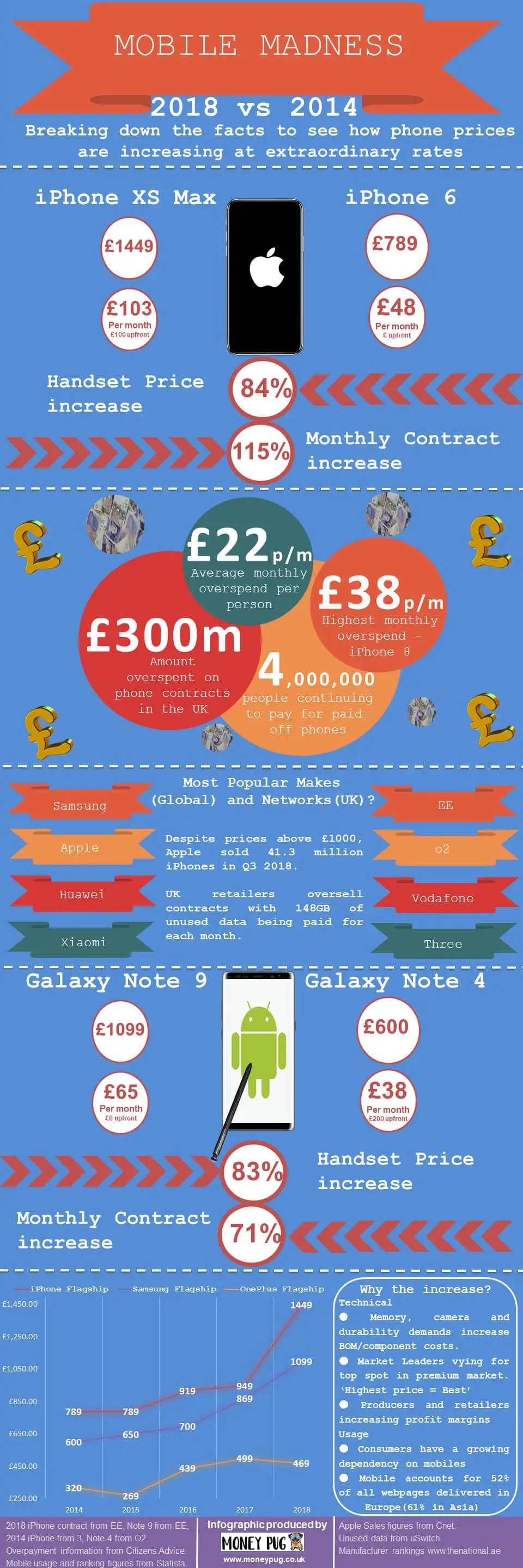Why are smartphone prices shooting up? – words Al Woods
Just like any sane consumer, I don’t want to have to keep paying out increasingly high sums of money for the latest technology, especially when the amount of money I have incoming isn’t increasing at anywhere near the same rate as the price of certain goods seems to be.
It is this factor that inspired this data collection and infographic from MoneyPug. When it comes to smartphones we all know that there is a dominant leader in the European markets, Apple.
Its nearest rival is Samsung, who has the market share across the Asian market and are 2nd in Europe. This market competition between the two rival companies has seen the price of smartphones rocket in recent years. Consumers were lucky enough that this competition had previously seen smartphone prices drop year on year between 2010 and 2014, but it seems as if these companies are here to get that money you saved back!
Comparing Apple in 2014 & 2018
The most recent flagship additions to the smartphone market will set the average consumer back almost £1,400 (iPhone XS), a huge increase compared to the price of Apple’s flagship in 2014, when the iPhone 6 Plus cost only £789.
Some of the best contract deals available still reach £98 per month (Three) compared to the then peak of £48pm. It is usually during times of mobile price comparison time that android users (like me) gleefully chirp up about the better pricing of our phones, and while that is the case for the majority of the market, the lead competitor to Apple in the android market, Samsung, is not helping us out.
Comparing Samsung in 2014 & 2018
When the Samsung Galaxy Note 4 was released it felt like a huge outlay for a phone, initially costing £600. If that price point didn’t hurt you, then you can be sure the potential battery fires that had them being recalled would also hurt you. However, now these issues have been fixed (we hope) what can we expect from the latest 2018 flagship model. £1099 for the Note 9+. Can we presume it cost £400 to fireproof this? It took the 2014 contract price from £38pm -inc.£99 upfront – to £61pm inc.£250 upfront (02).
Perhaps the famous giantkillers of the industry can come to the rescue of us mere mortals looking to save a few extra pounds?
Comparing OnePlus in 2014 & 2018
The OnePlus One, the original “flagship killer” was available for £320. A great price compared to its rivals at this time, and surely a figure they wouldn’t stray too far from in the coming years. Their latest contribution to the market, One Plus 6 (soon to be joined by 6T) now retails for £530. Another hefty percentage increase of 65%. While the increase percentage is below those mentioned previously it is still far beyond what many mobile phone aficionados would consider a giant killer, especially as its increasing price puts it in a different bracket unto which it will be judged with much more scrutiny.
When we take a step away from individual phones the image doesn’t get much better. Citizens advice recently announced that 4 million people in the UK have been overpaying for their phones. That is continuing to pay for their phone within the contract long after the contract has expired. This equated to an average of £22 per person per month. This figure could be as high as £38 for those poor souls who couldn’t resist the lure of an iPhone 8.
There are a few reasons as to why items will increase in price and the industry has had to deal with increased component costs but that can’t account for rises around 80%. These manufacturers and the retailers that sell phone contracts are capitalising on the ever-increasing dependency of individuals on mobile phones, especially regarding internet usage where over 50% of all webpages served were to mobile phones. This has allowed providers to change from under providing data, and hitting you with giant costs, to over providing data and ensuring you pay for more than you need. In the UK, 143 million gigabytes of paid for data goes unused each month according to uSwitch research.
Out of all this information I would say the most upsetting part of it all, is the fact that sales for these companies has increased and there hasn’t been an uproar over needless price rises. As apples iPhone X experienced sales of 41.3 million iPhones in Q3 2018, the first mainstream phone to break the £1000 mark, it looks like we have a steep journey ahead of us.
Why are smartphone prices shooting up? – words Al Woods









